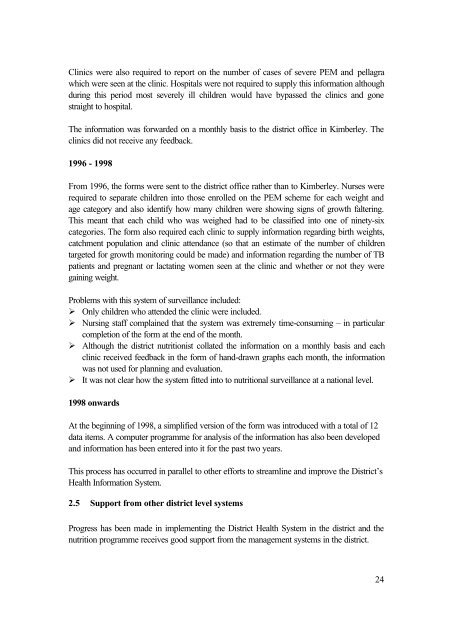Implementing an Integrated Nutrition Programme - Health Systems ...
Implementing an Integrated Nutrition Programme - Health Systems ...
Implementing an Integrated Nutrition Programme - Health Systems ...
Create successful ePaper yourself
Turn your PDF publications into a flip-book with our unique Google optimized e-Paper software.
Clinics were also required to report on the number of cases of severe PEM <strong>an</strong>d pellagra<br />
which were seen at the clinic. Hospitals were not required to supply this information although<br />
during this period most severely ill children would have bypassed the clinics <strong>an</strong>d gone<br />
straight to hospital.<br />
The information was forwarded on a monthly basis to the district office in Kimberley. The<br />
clinics did not receive <strong>an</strong>y feedback.<br />
1996 - 1998<br />
From 1996, the forms were sent to the district office rather th<strong>an</strong> to Kimberley. Nurses were<br />
required to separate children into those enrolled on the PEM scheme for each weight <strong>an</strong>d<br />
age category <strong>an</strong>d also identify how m<strong>an</strong>y children were showing signs of growth faltering.<br />
This me<strong>an</strong>t that each child who was weighed had to be classified into one of ninety-six<br />
categories. The form also required each clinic to supply information regarding birth weights,<br />
catchment population <strong>an</strong>d clinic attend<strong>an</strong>ce (so that <strong>an</strong> estimate of the number of children<br />
targeted for growth monitoring could be made) <strong>an</strong>d information regarding the number of TB<br />
patients <strong>an</strong>d pregn<strong>an</strong>t or lactating women seen at the clinic <strong>an</strong>d whether or not they were<br />
gaining weight.<br />
Problems with this system of surveill<strong>an</strong>ce included:<br />
‣ Only children who attended the clinic were included.<br />
‣ Nursing staff complained that the system was extremely time-consuming – in particular<br />
completion of the form at the end of the month.<br />
‣ Although the district nutritionist collated the information on a monthly basis <strong>an</strong>d each<br />
clinic received feedback in the form of h<strong>an</strong>d-drawn graphs each month, the information<br />
was not used for pl<strong>an</strong>ning <strong>an</strong>d evaluation.<br />
‣ It was not clear how the system fitted into to nutritional surveill<strong>an</strong>ce at a national level.<br />
1998 onwards<br />
At the beginning of 1998, a simplified version of the form was introduced with a total of 12<br />
data items. A computer programme for <strong>an</strong>alysis of the information has also been developed<br />
<strong>an</strong>d information has been entered into it for the past two years.<br />
This process has occurred in parallel to other efforts to streamline <strong>an</strong>d improve the District’s<br />
<strong>Health</strong> Information System.<br />
2.5 Support from other district level systems<br />
Progress has been made in implementing the District <strong>Health</strong> System in the district <strong>an</strong>d the<br />
nutrition programme receives good support from the m<strong>an</strong>agement systems in the district.<br />
24
















